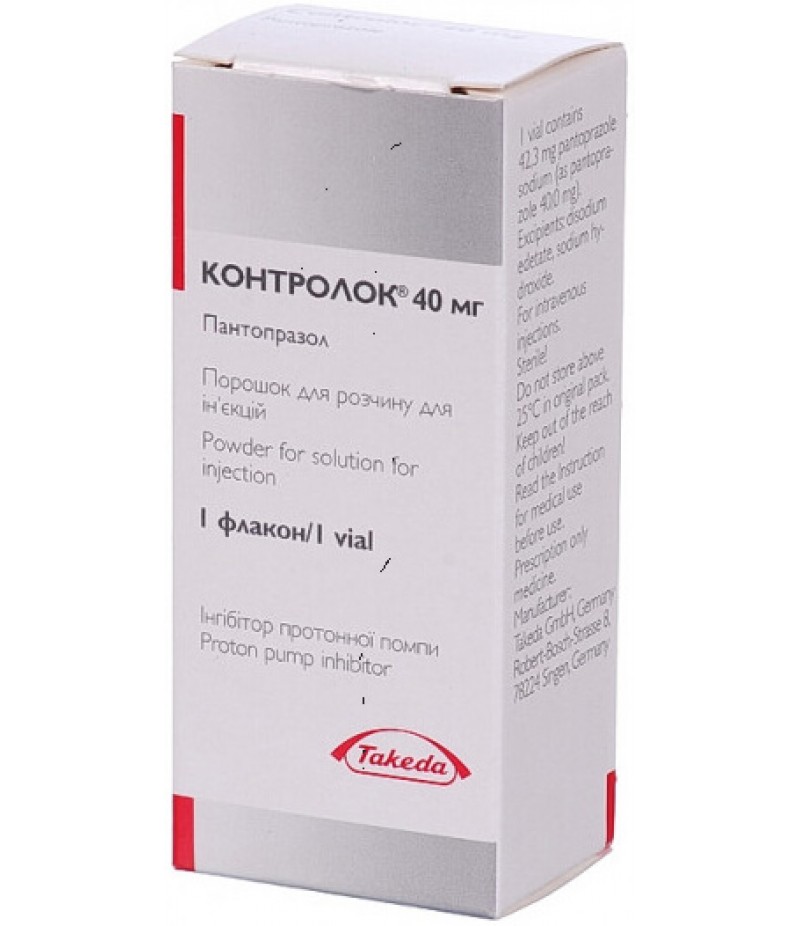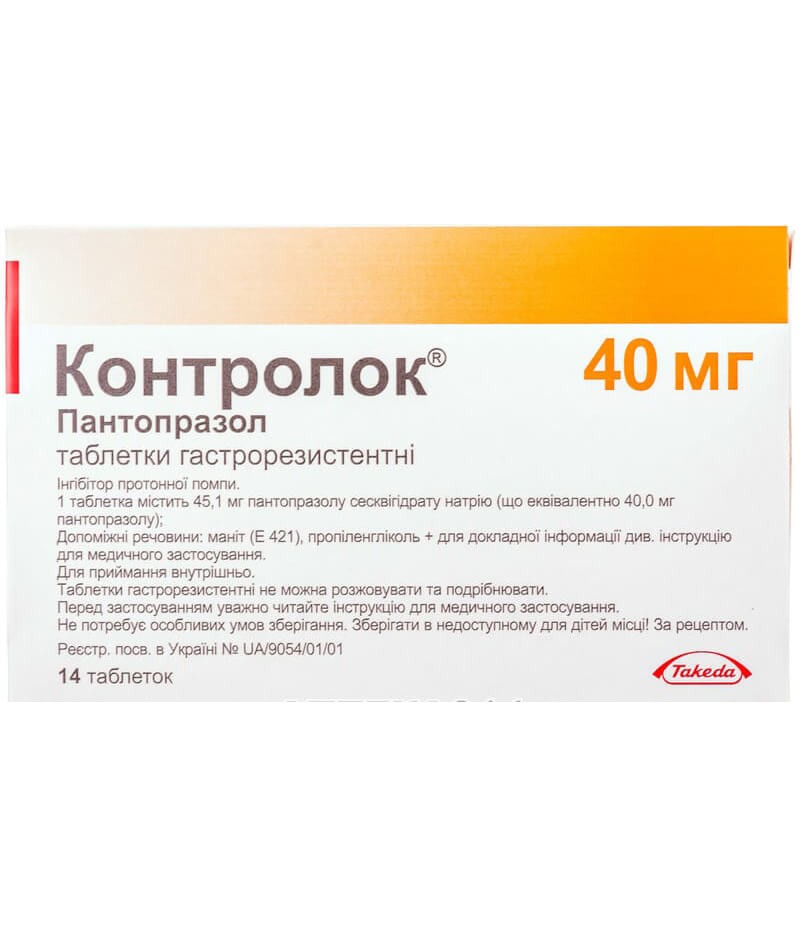Controloc powder for injections 40mg #1
- $21.30
- 3 or more $20.90
- Availability:In Stock
Controloc powder for injections instructionYou can buy Controloc powder for injections hereForm of release, composition and packagingPowder for the preparation of a solution for intravenous administration as a dry substance white ..
Tags: powder
Controloc powder for injections instruction
You can buy Controloc powder for injections here
Form of release, composition and packaging
Powder for the preparation of a solution for intravenous administration as a dry substance white or almost white.
1 f.
pantoprazole sodium sesquihydrate 45.1 mg,
which corresponds to the content of pantoprazole sodium (anhydride) 42.3 mg,
which corresponds to the content of pantoprazole (free acid) 40 mg
Excipients: disodium edetate - 1 mg, sodium hydroxide - 0.24 mg.
pharmachologic effect
Proton pump inhibitor (H + -K + -ATPase).
It blocks the final stage of hydrochloric acid secretion, reducing basal and stimulated secretion, regardless of the nature of the stimulus.
Compared to other proton pump inhibitors, the Controller has a greater chemical stability at neutral pH, and a lower interaction potential with a liver oxidase system dependent on cytochrome P450. Therefore Controller does not interact with many other drugs.
Pharmacokinetics
Pharmacokinetics is the same as after a single, and after repeated use of Controloc for injections.
Suction
In the dose range of 10 to 80 mg, the kinetic direct concentration of pantoprazole in blood plasma has a linear relationship both after oral administration and after intravenous administration.
Distribution
The binding of pantoprazole to plasma proteins is 98%.
Vd is 0.15 l / kg, clearance is 0.1 l / h / kg.
Metabolism
Metabolised in the liver. The main metabolite in the blood plasma and in urine is desmethylpentoprazole, conjugating with sulfate.
Excretion
The main way of excretion is by kidneys (about 80%) in the form of metabolites of pantoprazole, in a small amount is excreted through the intestine. T1 / 2 of Controloc for injections - 1 hour, T1 / 2 metabolite - about 1.5 hours. There were several cases of delayed elimination.
Pharmacokinetics in special clinical cases
When pantoprazole is used in patients with impaired renal function (including patients on hemodialysis), no dose reduction is required. As in healthy patients, T1 / 2 pantoprazole is short. Only a very small part of Controloc for injections is dialyzed. Do not cumulate.
In patients with cirrhosis of the liver (classes A, B on the Child-Pugh scale), the T1 / 2 value increases to 7-9 h and the AUC increases 5-7 times, Cmax in the blood plasma increases by 1.5 times in comparison with patients with normal function liver.
A slight increase in AUC and Cmax in elderly patients is not clinically significant.
Indications for Controloc for injections
- peptic ulcer of the stomach and duodenum (in the phase of exacerbation), erosive gastritis (including associated with the intake of NSAIDs);
- gastroesophageal reflux disease (GERD): treatment of erosive reflux esophagitis, symptomatic treatment of non-erosive reflux disease (NERD);
- Zollinger-Ellison syndrome;
- eradication of Helicobacter pylori in combination with antibacterial agents;
- treatment and prevention of stress ulcers, as well as their complications (bleeding, perforation, penetration).
Contraindications
- joint application with atazanavir;
- pregnancy;
- the period of lactation (breastfeeding);
- children and adolescence under 18;
- Hypersensitivity to the components of the drug.
Dosage
Controloc for injections should be administered iv only in those cases when it is impossible to take Controloc for injections inside. Duration of application - no more than 7 days. If there is a possibility of oral administration, intravenous administration should be replaced by ingestion of the tablet with enteric coating.
Peptic ulcer of the stomach and duodenum (in the phase of exacerbation), erosive gastritis (including those associated with taking NSAIDs), GERD: the recommended dose is 40 mg (1 bottle) per day.
Zollinger-Ellison syndrome: with the long-term treatment of Zolinger-Ellison syndrome and other pathological hypersecretory conditions, the recommended daily dose for IV administration at the beginning of treatment is 80 mg. After this, the dose may be increased or decreased. If the drug is used in a daily dose of more than 80 mg, the dose should be divided and administered 2 times / day. It is possible to temporarily increase the daily dose to 160 mg, but not longer than necessary for adequate acidity control. If an emergency acidity control is required, the initial dose of 80 mg 2 times / day is sufficient to reduce the acid release in the range of less than 10 mEq / h for 1 h in most patients.
Treatment and prevention of stress ulcers, as well as their complications (bleeding, perforation, penetration): the recommended dose is 80 mg / day. If Controloc for injections is used in a daily dose of more than 80 mg, the dose should be divided and administered 2 times / day. Perhaps a temporary increase in the daily dose to 160 mg.
In patients with severe impairment of liver function, the daily dose should not exceed 20 mg of pantoprazole (half a vial).
In elderly patients and patients with impaired renal function, dose adjustment is not required, but the recommended daily dose of pantoprazole 40 mg should not be exceeded.
Rules for the preparation and injection of injection solutions
To prepare a ready-to-use solution for injection, 10 ml of 0.9% sodium chloride solution is added to a vial containing a dry substance. The ready-made solution can be administered in an amount of 10 ml, it is also permissible to dilute it in 100 ml of a 0.9% solution of sodium chloride or in a 5% solution of glucose.
Do not use any other solvents!
Controloc for injections should be administered within 2-15 minutes.
The prepared solution is stable for 12 hours after preparation. However, it is recommended to use the solution immediately after preparation in order to avoid microbial contamination.
Side effects of Controloc for injections
When applying the drug Controloc for injections in accordance with the indications and in the recommended doses, adverse reactions are extremely rare. The most common thrombophlebitis at the injection site; about 1% of cases - diarrhea and headache.
Determination of the frequency of adverse reactions: very often (≥1 / 10), often (≥1 / 100 and <1/10), infrequently (≥1 / 1000 and <1/100), rarely (≥ 1/10 000 and <1 / 1000), very rarely (<1/10 000, including individual cases), the frequency is unknown (it is impossible to estimate based on available data).
On the part of the digestive system: infrequently - diarrhea, nausea / vomiting, bloating and flatulence, constipation, dry mouth, discomfort and abdominal pain.
From the liver and bile ducts: infrequently - increased activity of liver enzymes (AST, GGT); rarely - increased bilirubin levels; frequency unknown - hepatocellular injury, jaundice.
From the hemopoietic system: rarely - agranulocytosis; very rarely - thrombocytopenia, leukopenia, pancytopenia.
From the nervous system: infrequently - headache, dizziness; rarely - dysgeusia.
From the side of the organ of vision: rarely - visual impairment (fogging).
From the side of the psyche: infrequently - a violation of sleep; rarely - depression (including exacerbations of existing disorders); very rarely - disorientation (including exacerbations of existing disorders); the frequency is unknown - hallucinations, confusion (especially in patients who are predisposed to it), as well as the possible exacerbation of symptoms when they exist before the start of therapy.
From the side of the urinary system: the frequency is unknown - interstitial nephritis.
From the skin and subcutaneous tissues: infrequently - exanthema / rash, itching; frequency unknown - malignant exudative erythema (Stevens-Johnson syndrome), exudative erythema multiforme, toxic epidermal necrolysis, photosensitivity.
From the musculoskeletal system: rarely - arthralgia, myalgia.
From the side of metabolism: rarely - hyperlipidemia and increased concentration of lipids (triglycerides, cholesterols), change in body weight; frequency is unknown - hyponatremia, hypomagnesemia.
Allergic reactions: rarely - hives, angioedema.
From the side of the immune system: rarely - hypersensitivity (including anaphylactic reactions and anaphylactic shock).
From the endocrine system: rarely - gynecomastia.
General reactions: infrequent - weakness, fatigue and malaise; rarely - fever, peripheral edema.
Local reactions: often - thrombophlebitis at the injection site.
Overdose with Controloc for injections
To date, overdose phenomena have not been observed as a result of the use of the drug Controloc for injections. Doses up to 240 mg with IV for 2 min were well tolerated.
Treatment: in case of an overdose and only if there are clinical manifestations, symptomatic and supportive therapy is performed. Pantoprazole is not excreted by hemodialysis.
Drug Interactions
Simultaneous use of the drug Controloc for injections can reduce the absorption of drugs whose bioavailability depends on the pH of the stomach environment (eg, ketoconazole, itraconazole, postazonazole and such as erlotinib).
Controloc for injections can be prescribed without the risk of undesirable drug interactions to patients with cardiovascular diseases taking cardiac glycosides (digoxin), slow calcium channel blockers (nifedipine), beta-blockers (metoprolol); patients with gastrointestinal diseases who take antacids, antibiotics (amoxicillin, clarithromycin), metronidazole; patients taking oral contraceptives containing levonorgestrel and ethinylestradiol; patients taking NSAIDs (diclofenac, naproxen, piroxicam); patients with diseases of the endocrine system, taking glibenclamide, levothyroxine sodium; patients with anxiety and sleep disorders receiving diazepam; patients with epilepsy taking carbamazepine and phenytoin; patients taking indirect anticoagulants, such as warfarin and fenprocumone (under the control of prothrombin time and INR at the beginning and at the end of treatment, as well as during an irregular intake of pantoprazole, patients undergoing transplantation taking cyclosporin, tacrolimus.
There was also a lack of drug interaction with theophylline, caffeine and ethanol.
special instructions
The use of pantoprazole is not indicated for the treatment of mild gastrointestinal complaints, such as dyspepsia of a neurogenic genesis.
Patients should consult a physician if the following symptoms occur:
Significant unintended weight loss;
- periodic vomiting;
- Swallowing disorder;
Anemia, melena.
If you suspect or have a stomach ulcer before starting treatment with pantoprazole, you should rule out the possibility of a malignant neoplasm. treatment with Controloc for injections can mask symptoms and delay proper diagnosis.
In patients with severe impairment of liver function, biochemical blood counts must be monitored. When the activity of liver enzymes increases, the drug should be discontinued.
When taking drugs that reduce the acidity of the gastric juice, the risk of gastrointestinal infections, which are caused by the bacteria of the genus Salmonella spp., Campylobacter spp., Is slightly increased.
Impact on the ability to drive vehicles and manage mechanisms
During treatment, patients should refrain from driving and other mechanisms requiring increased attention, due to the likelihood of dizziness and visual impairment.
Pregnancy and lactemia
Contraindicated the use of the drug Controloc for injections during pregnancy and lactation (breastfeeding).
Application in childhood
Contraindicated in children and adolescents under 18 years.
In case of violations of kidney function
Do not increase the daily dose of pantoprazole 40 mg in patients with impaired renal function, as well as elderly patients.
With violations of liver function
With caution, use Controloc for injections for liver failure.
In individuals with severe hepatic insufficiency, the daily dose should be reduced to 20 mg of pantoprazole. In addition, in such patients during therapy with the drug Controloc for injections, it is necessary to monitor liver enzymes. If their level is raised, treatment should be interrupted.
Application in old age
In elderly patients, dose adjustment is not required, but the recommended daily dose of pantoprazole 40 mg should not be exceeded.
Conditions of leave from pharmacies
You can buy Controloc for injections without a prescription.
Terms and conditions of storage
Controloc for injections should be stored out of reach of children, protected from light at a temperature of no higher than 25 ° C. Shelf life - 2 years.


